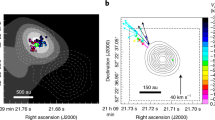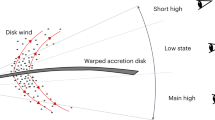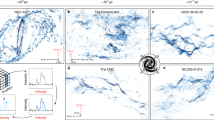Abstract
Mira is one of the first variable stars ever discovered1 and it is the prototype (and also the nearest example) of a class of low-to-intermediate-mass stars in the late stages of stellar evolution. These stars are relatively common and they return a large fraction of their original mass to the interstellar medium (ISM) (ref. 2) through a processed, dusty, molecular wind. Thus stars in Mira’s stage of evolution have a direct impact on subsequent star and planet formation in their host galaxy. Previously, the only direct observation3 of the interaction between Mira-type stellar winds and the ISM was in the infrared. Here we report the discovery of an ultraviolet-emitting bow shock and turbulent wake extending over 2 degrees on the sky, arising from Mira’s large space velocity and the interaction between its wind and the ISM. The wake is visible only in the far ultraviolet and is consistent with an unusual emission mechanism whereby molecular hydrogen is excited by turbulent mixing of cool molecular gas and shock-heated gas. This wind wake is a tracer of the past 30,000 years of Mira’s mass-loss history and provides an excellent laboratory for studying turbulent stellar wind–ISM interactions.
This is a preview of subscription content, access via your institution
Access options
Subscribe to this journal
Receive 51 print issues and online access
$199.00 per year
only $3.90 per issue
Buy this article
- Purchase on Springer Link
- Instant access to full article PDF
Prices may be subject to local taxes which are calculated during checkout



Similar content being viewed by others
References
Hoffleit, D. History of the discovery of Mira stars. J. Am. Ass. Var. Star Observ. 25, 115–136 (1997)
Schröder, K.-P. & Sedlmayr, E. The galactic mass injection from cool stellar winds of the 1 to 2.5 stars in the solar neighbourhood. Astron. Astrophys. 366, 913–922 (2001)
Ueta, T. S. et al. Detection of a far-infrared bow shock nebula around R Hya: the first MIRIAD results. Astrophys. J. 648, L39–L42 (2006)
Prieur, J. L. et al. High angular resolution observations of late-type stars. Astrophys. J. 139, 249–258 (2002)
Karovska, M., Schlegel, E., Hack, W., Raymond, J. C. & Wood, B. E. A. Large X-ray outburst in Mira A. Astrophys. J. 623, L137–L140 (2005)
Ireland, M. J. et al. Born again protoplanetary disk around Mira B. Astrophys. J. 662, 651–657 (2007)
Martin, D. C. et al. The Galaxy Evolution Explorer: a space ultraviolet survey mission. Astrophys. J. 619, L1–L4 (2005)
Knapp, G. R., Pourbaix, D., Platais, I. & Jorissen, A. Reprocessing the Hipparcos data of evolved stars. III. Revised Hipparcos period-luminosity relationship for galactic long-period variable stars. Astron. Astrophys. 403, 993–1002 (2003)
Turon, C. et al. Version 2 of the Hipparcos Input Catalogue. Bull. Inf. Centre Donnees Stell. 43, 5–6 (1993)
Evans, D. S. The revision of the general catalog of radial velocities. IAU Symp. 30, 57–62 (1967)
Ryde, N. Gustafsson, B. Eriksson, K. & Hinkle, K. H. Mira’s wind explored in scattering infrared CO lines. Astrophys. J. 545, 945–956 (2000)
Josselin, E. et al. Strong asymmetries in the neutral envelope of Mira. Astron. Astrophys. 362, 255–262 (2000)
Ferland, G. J. et al. CLOUDY 90: numerical simulation of plasmas and their spectra. Publ. Astron. Soc. Pacif. 110, 761–778 (1998)
Hartigan, P., Raymond, J. & Hartmann, L. Radiative bow shock models of Herbig–Haro objects. Astrophys. J. 316, 323–348 (1987)
Martin, C. Hurwitz, M. & Bowyer, S. Discovery of molecular hydrogen fluorescence in the diffuse interstellar medium. Astrophys. J. 354, 220–228 (1990)
Liu, W. & Dalgarno, A. The ultraviolet spectrum of the Jovian dayglow. Astrophys. J. 462, 502–518 (1996)
Khakoo, M. A., Trajimar, S., McAdams, R. & Shyn, T. W. Electron-impact excitation cross sections for the state of H2. Phys. Rev. A. 35, 2832–2837 (1987)
Bowers, P. F. & Knapp, G. R. Detection of HI emission in the circumstellar envelope of Omicron Ceti (Mira). Astrophys. J. 332, 299–304 (1988)
Raymond, J. C., Blair, W. P. & Long, K. S. Hopkins ultraviolet telescope observations of H2 emission lines from HH 2. Astrophys. J. 489, 314–318 (1997)
Vassiliadis, E. & Wood, P. R. Evolution of low- and intermediate-mass stars to the end of the asymptotic giant branch with mass loss. Astrophys. J. 413, 641–657 (1993)
Speck, A. K., Meixner, M. & Knapp, G. R. Discovery of parsec-sized dust shells around AFGL 2688 and AFGL 618. Astrophys. J. 545, L145–L148 (2000)
Scargle, J. D. Studies in astronomical time series analysis. II—Statistical aspects of spectral analysis of unevenly spaced data. Astrophys. J. 263, 835–853 (1982)
Wood, P. R. in Miras to Planetary Nebulae: Which Path for Stellar Evolution? (eds Mennessier, M. O. & Omont A.) 67–84 (Editions Frontieres, Gif-sur-Yvette, 1990)
Wareing, C. J. et al. Detached shells as tracers of asymptotic giant branch-interstellar medium bow shocks. Mon. Not. R. Astron. Soc. 372, L63–L67 (2006)
Wareing, C. J., Zijlstra, A. A. & O’Brien, T. J. Vortices in the wakes of AGB stars. Astrophys. J. 660, L129–L132 (2007)
Acknowledgements
We thank B. Cenko, S. Browne, S. Kulkarni and F. Harrison for assistance in obtaining optical data, and M. Shara and P. Szkody for comments. This work was supported by the National Aeronautics and Space Administration.
Author information
Authors and Affiliations
Corresponding author
Ethics declarations
Competing interests
Reprints and permissions information is available at www.nature.com/reprints. The authors declare no competing financial interests.
Supplementary information
Supplementary Figures
This file contains Supplementary Figures S1-S3 with Legends and additional references. Supplementary Figures S1 and S2 show the far and near ultra-violet images of the near-tail region of the Mira nebula with coordinate grids. Supplementary Figure S3 illustrates the results of two-dimensional fits of seven emission models to the GALEX grism image. (PDF 1489 kb)
Rights and permissions
About this article
Cite this article
Martin, D., Seibert, M., Neill, J. et al. A turbulent wake as a tracer of 30,000 years of Mira’s mass loss history. Nature 448, 780–783 (2007). https://doi.org/10.1038/nature06003
Received:
Accepted:
Published:
Issue Date:
DOI: https://doi.org/10.1038/nature06003
This article is cited by
-
Ram pressure stripping in high-density environments
The Astronomy and Astrophysics Review (2022)
-
The sharpest ultraviolet view of the star formation in an extreme environment of the nearest Jellyfish Galaxy IC 3418
Journal of Astrophysics and Astronomy (2021)
-
A blue ring nebula from a stellar merger several thousand years ago
Nature (2020)
-
CHESS: An innovative concept for high-resolution, far-UV spectroscopy
Experimental Astronomy (2020)
-
Heliosheath Processes and the Structure of the Heliopause: Modeling Energetic Particles, Cosmic Rays, and Magnetic Fields
Space Science Reviews (2017)
Comments
By submitting a comment you agree to abide by our Terms and Community Guidelines. If you find something abusive or that does not comply with our terms or guidelines please flag it as inappropriate.



